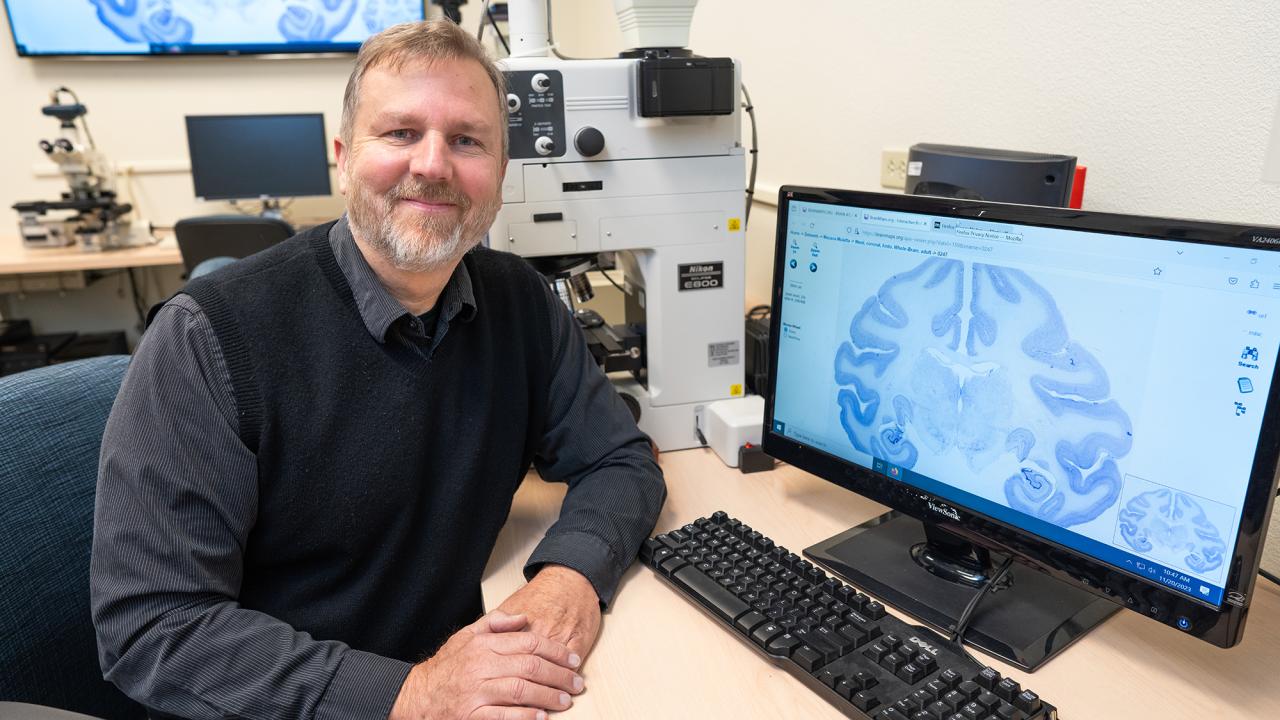
$15 Million Grant Will Support Study on the Role of the Thalamus in Cognitive Control and Schizophrenia
New research suggests that this brain area focuses our attention – and might also be involved with schizophrenia
When it comes to brain anatomy, the thalamus occupies a humble position. It sits at the top of our brainstem — an apparent vestige of our reptilian past — and is dwarfed by the massive, wrinkled cerebral cortex, which sits above it. The cortex is often credited as the throne of human intellect. But a team of researchers across the country, with UC Davis led by W. Martin Usrey, sees the thalamus as a critical coordinator of our thoughts and perceptions – and pivotal in human disease.
“The cerebral cortex and the thalamus are partners,” says Usrey, who is a professor and chair in the Department of Neurobiology, Physiology and Behavior. “Everything that the cerebral cortex does, the thalamus is involved.”
In April, Usrey, along with a consortium of researchers at seven other universities, received a $15 million Conte Center grant from the National Institutes of Health to decipher the flow of information connecting the thalamus and cortex. This broad, interdisciplinary effort could have “a transformative impact,” he says and shed light on cognitive control and the causes of schizophrenia.
Spotlight of Attention
It’s understandable why the cortex was long viewed as the seat of intelligence. This outer covering of the brain expanded in mammals and enlarged even further during primate evolution. The human cortex contains nearly 200 specialized areas, responsible for everything from recognizing faces to executing a precise tennis backhand.
In contrast, says Usrey, people long viewed the thalamus as a perfunctory relay station, which passed sensory information to upper management in the cortex — where all of the decisions were made.
But as Usrey and others studied how visual information flows through the brain, they increasingly suspected that the thalamus plays a more decisive role.
When you gaze through a window at the landscape outside, signals from your eyes pass through a series of cortical visual areas, called V1, V2, V3, and so on. Those successive areas identify lines and edges in different parts of the visual field, and assemble them into discrete objects, which other cortical areas will identify as trees, cars, and shadows.

As this cascade unfolds, information travels directly from one cortical area to the next. But scientists have discovered that signals also travel an indirect route between cortical areas. Signals from V1, for example, travel down to the thalamus, and then back up to V2 — and this is where things get interesting.
“The connections from visual areas down to the thalamus are actually stronger than those going directly from V1 to V2,” says Usrey.
And when this part of the thalamus is damaged through a stroke or brain injury, people experience telltale deficits: they have trouble paying attention as they look for particular shapes on a computer screen — especially if the experiment is designed to include plenty of distractions.
This led researchers to suspect that the thalamus helps direct the “spotlight of attention,” says Usrey.
If a person is searching in the bushes for a frisbee, for example, the thalamus may prioritize certain details – say, the perfectly curved edges or bright orange color that match the object of interest – amplifying them from V1 to V2, and onward through the cortex. This would streamline the process of finding the frisbee.
With the Conte Center grant, Usrey’s team will test this theory through experiments that monitor brain responses to specialized tasks, while selectively inhibiting either the direct path from V1 to V2, or the indirect path that runs through the thalamus, using a technique called optogenetics.
This way, Usrey and his colleagues will test how silencing one pathway or the other changes brain function. Teams at other universities are planning to do complementary experiments, using functional magnetic resonance imaging (fMRI) to track brain activity when healthy volunteers, or people with schizophrenia, perform the same tasks.

Alarming Sensations
In addition to elucidating human cognition, their research could also shed light on the causes of serious brain diseases, such as schizophrenia.
“This is because the thalamus doesn’t just filter and prioritize information,” says Usrey, “it may also serve a coordinating function, telling one part of the brain what the other parts are doing.” Errors in this process could underly some of the most distressing symptoms of schizophrenia.
If a person picks up a cup of coffee, the thalamus relays a carbon copy of that command from the motor cortex, where the command originated, to the prefrontal cortex (PFC), an area involved in conscious planning and decision making. That message “lets the PFC know that the movement is being self-generated,” says Usrey. But if the PFC never receives that message, the person might experience the alarming feeling that someone else took control of their arm and grabbed the coffee.
People with schizophrenia are known to have weakened connections between their thalamus and PFC — suggesting that it really might happen this way. “This is tantalizing speculation,” says Usrey. “But if we can understand these pathways, maybe we’ll have a toehold into new treatments for the disease.”
Understanding the thalamus could also answer an age-old question that many people have asked: Why can we be tickled by other people — but we can’t tickle ourselves? Usrey believes that the thalamus might prevent self-tickling by letting us know that those sensations on our feet are being generated by our own fingers.
If this is true, then a humble nubbin of gray matter — long dismissed as a vestigial holdover from our reptilian brain — might actually sit at the center of human experience.
Funding is provided by a grant from the National Institutes of Health.
Media Resources
- Douglas Fox is a freelance science writer based in the Bay Area.
- Usrey Lab
